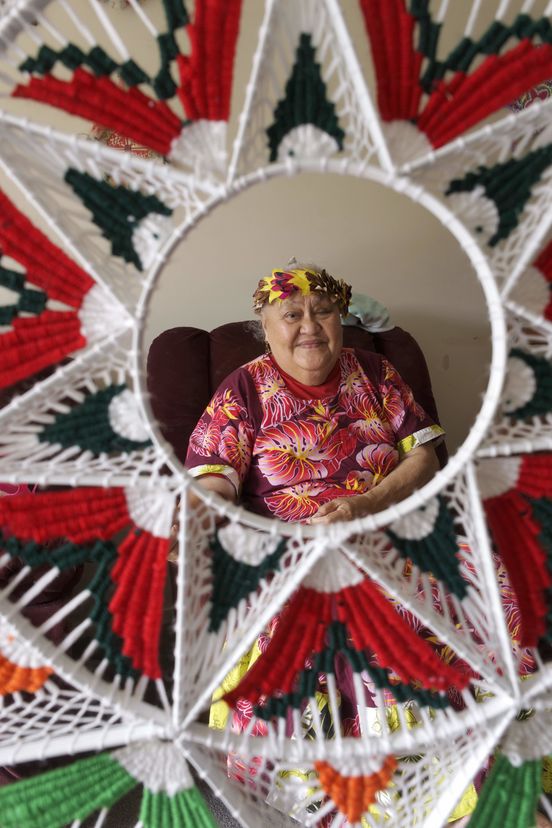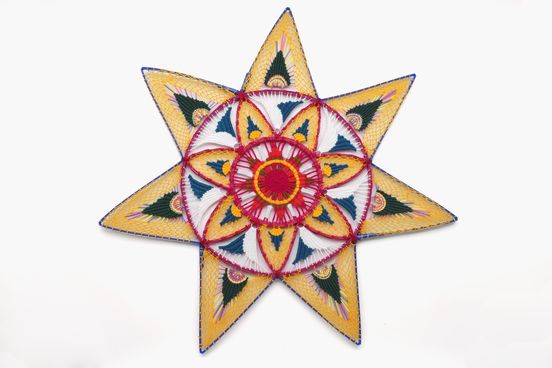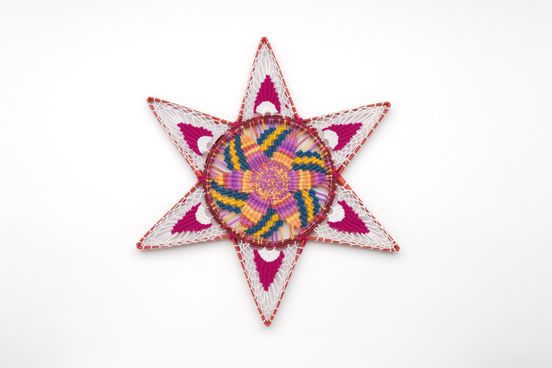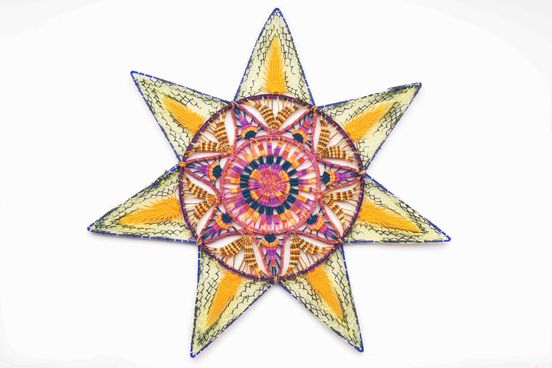Lakiloko Keakea’s fafetu are kaleidoscopic – mesmerising, brightly-lit, and filled with an array of extraordinary patterns. While Lakiloko takes a six or seven pointed star as her frame again and again, no two pieces are identical – their interiors are each intricately singular and individual.
Fafetu is the first major solo exhibition of Lakiloko’s work, featuring pieces produced within the last two years, building on a practice of over five decades.
Lakiloko’s fafetu mix a boldness of colour with a delicacy of action – crafted using a number of distinct weaving and crochet techniques, including tio: a type of kolose (Tuvalu crochet) and lalaga (weaving with a needle). Her fafetu embody the Tuvalu approach to living; infused with repeating actions, popping colours and an undeniable vibrancy. The work holds the same bright spirit of celebration that is seen in kolose and fatele (Tuvalu dancing accompanied by song), with all rhythms leading back towards a place of culture.
Her wild palette demonstrates the Tuvalu delight in vibrant colour – seen also in kolose, and Tuvalu celebratory garments. On the atolls, many of these colours are created using plant-based dyes on fibre. An expansion in material options came with Lakiloko’s move to Aotearoa in 1996, providing a greater range of bright, synthetic materials to weave alongside their natural counterparts.
The works featured in Fafetu have been created using a mix of manufactured and natural materials including wool, synthetic ribbon, cloth ribbon, and plastic cargo ties. The largest piece commissioned for the exhibition (Lakiloko’s biggest fafetu to date) has been woven for the first time on a steel frame fabricated specifically for Fafetu – expanding Lakiloko’s work to a previously untested scale.
Lakiloko is a prolific maker – in her endless rhythm of knotting and weaving, her practice is making as living – an entwining of threads with daily tasks. She continues to work at her house in Ranui, surrounded by the comings and goings of friends and relatives – her mesmerising objects emerging from the most domestic and well-known of environments – their production an integrated part of the flow of home and family.
Fafetu is curated by Malama T-Pole, she is an advocate for Tuvalu art forms and a member of the Niutao Community Trust. Objectspace and the Trust have worked in partnership for two years with Lakiloko Keakea and her family, bringing Fafetu to life.
--
Lakiloko Keakea was born on Nui Island, Tuvalu, in 1949. She is an artist of mea taulima; things created with hands.
In 1957 Lakiloko moved to Niutao Island, and here began to practice kolose. In the 1970’s Lakiloko joined a women’s arts group called Fakapotopotoga Fafine Tuvalu, which included women from all the atolls in Tuvalu, each sharing knowledge of the art practices distinct to their island. During the 70’s several women from the collective travelled together to the Marshall Islands, returning with the star-shaped design used in fafetu. In 1996, Lakiloko moved to New Zealand – her art-making practice is now based at her home in Ranui, Auckland. Lakiloko is a key member of the Tuvalu Women’s arts collective Fafine Niutao I Aotearoa.
Lakiloko’s work has been exhibited at Auckland Art Gallery Toi o Tāmaki, in Home AKL: Artists of Pacific Heritage in Auckland, 2012, and in Kolose: The Art of Tuvalu Crochet, at Māngere Arts Centre Ngā Tohu o Uenuku, 2014, Lake House Arts Centre, 2014, and Pātaka Art & Museum, 2017. Lakiloko’s work, Fafetu, 2012, is on display as part of the Seeing Moana Oceania exhibition (June 2018 – December 2019) at Auckland Art Gallery Toi o Tāmaki. Her more than fifty years of knowledge and experience as a maker, and her significant contribution to maintaining Tuvalu art in Aotearoa, was acknowledged by Creative New Zealand in 2017 when she was awarded the Pacific Heritage Art Award.

Lakiloko Keakea, 2018.


